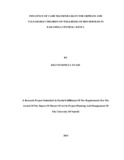| dc.description.abstract | Cash Transfer Programmes are an essential constituent of social policy, assessing the
Programme from the beneficiaries‟ perspective is important in order to determine its
influence on the beneficiaries‟ well being. This study sought to establish the influence of
cash transfer grant for orphans and vulnerable children on wellbeing of households in
Kakamega Central. The objectives guiding this study were; to assess how households
utilise Cash Transfer grant for Orphans and Vulnerable children for their wellbeing, to
establish the perceived influence of Cash transfer grant for orphans and vulnerable
children on food consumption and food security of household‟s wellbeing, to assess the
influence of cash transfer grant on education of orphans and vulnerable children for their
household‟s well being and to examine the influence of cash transfer grant for orphans
and vulnerable children on the social status and social relations for their household‟s
wellbeing. The literature reviewed focused on the influence of cash transfer to the well
being of households.The methodology used in this study was descriptive survey which
utilized case study and survey studies. Quantitative and Qualitative methods of data
collection were also employed, questionnaires were used as a quantitative method to
collect primary data from respondents who were heads of households i.e caregivers while
Key Informant Interview Guide was developed to collect data from key informant who
was the Sub County Children‟s Officer and lastly secondary data was collected through a
review of existing policy documents, programme documents and other authentic
materials. The target population was 863 respondents who are households heads(Care
givers) benefiting from the cash transfer in Kakamega Central sub-county.The sample
size was269 respondents, this was in conformity with Krejcie and Morgan (1970) table of
determining sample size. Both probability (Purposive) and non-probability (Simple
random) sampling procedure were used; purposive sampling was used to select the Key
Informant while simple random sampling was used to select respondents who were the
heads of beneficiary households. For reliability, questionnaires were pretested through
administering them to few respondents through piloting then compared the findings to
actual data collected while to ensure validity, the instruments were verified by Sub
County Children‟s Officer and my supervisor and their opinions were incorporated in the
final questionnaire. Data was analyzed using SPSS for windows 11.5 where frequency,
tables and percentages and cross tabulation conducted in determination of individual
influences of factors among the objectives under study. The response rate was 84.03%
and results were presented in tabular forms. Basing on the objectives of study, it was
found out that majority of respondents 58.1% prioritized cash transfer grant on purchase
of food with a huge number of them 76% saying this grant is not adequate. On food
security, majority 78.6% confirmed that cash transfer grant improved food security.
Majority of respondents 54.6% agreed that cash transfer had improved education by
proving learning materials hence improving school performance 56.1%. Lastly, large
number of respondents 46.1% confirmed that the cash transfer had improved their social
relations and social relations in the community hence those applauding the cash transfer
grant as real useful stood at 78.6%. | en_US |

